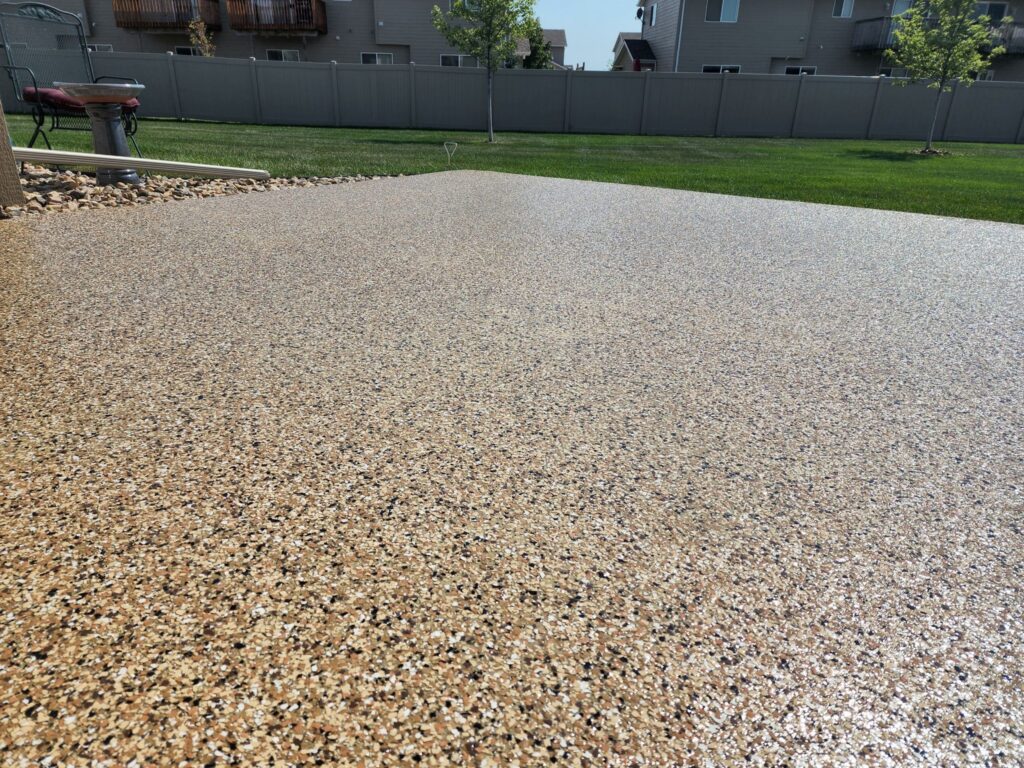Whether you are repairing a concrete floor in your home, or resurfacing it, concrete floor epoxy coating offer many benefits. They can cover and protect a damaged concrete floor, reduce stress cracks, and meet ADA-slip resistance requirements.

Concrete Floor Epoxy Coating to Protect your basement floor
Adding epoxy coatings to your basement floor is a great way to enhance its appearance and protect it from water, stains and other damage. It also helps keep your kids safe and prevents slip and fall accidents.
It’s no secret that a damp basement is a breeding ground for mold and mildew. To prevent this problem, you should invest in a moisture test kit.
The calcium chloride moisture test kit is the most accurate. It requires a little patience, but it’s well worth the effort. You should do this test at least once every two weeks. You may need to grind the surface a bit.
The best basement floor epoxy will last years. You can choose from a variety of finishes and colors to suit your style and budget. It’s also easy to maintain.
A quality epoxy will provide you with a slip-free, stain-resistant flooring that’s easy to clean. You’ll also find that it lasts longer than many other types of floor coating.
Epoxy Coating to Cover concrete damage
Whether you have a new concrete floor or are looking to fix a damaged concrete floor, epoxy coatings can provide a durable, damage-resistant finish. The coatings are made from a thermosetting resin and hardener that binds with the concrete surface. This makes the finished product waterproof, stain-proof, and mold & mildew-resistant.
You can choose between three types of epoxy floor paints. Each of them offers different benefits. If you want a durable, high-gloss finish, look for a water-based, solvent-based, or high-solids epoxy. The higher the solids, the more solid elements it contains.
If you are planning to apply an epoxy coat to your concrete floor, make sure you do it right the first time. If you do not take the proper measures, you may end up with uneven or dull coatings. You will also need to remove any sealant from your concrete.
If you do not get the right kind of epoxy coat, you could end up with bubbles, pinholes, or craters. This can occur because air and liquids are trapped in the floor’s pores.
Concrete Floor Epoxy Coating to Meet ADA-slip resistance requirements
ADA-slip resistance requirements require surfaces to be slip-resistant. These include ramps and floors. This means that these surfaces must be safe and stable, which is difficult to do when they are rough and uneven.
A slip-and-fall accident can cost an individual or a business enormous amounts of money and cause needless physical trauma. These accidents can also cause emotional distress. In addition, the party that is legally responsible may face stiff liability payouts, administrative costs, and increased insurance premiums.
The American with Disabilities Act (ADA) of 1990 prohibits discrimination on the basis of disability in state and local government, telecommunications, transportation, and public accommodations. It also guarantees equal opportunities for individuals with disabilities. The ADA has been widely adopted in the U.S.
There are three basic ways to determine if a surface meets ADA-slip resistance requirements: testing, analysis, and design. One reliable method to test for slip resistance is the Pendulum DCOF (Dynamic Coefficient of Friction) test. This is a scientific test that has been in use for over 50 years. The resulting “Pendulum Test Value” indicates the level of slip resistance. It can range from near zero to more than 100.
Epoxy Coating to Reduce stress cracks
Several types of epoxy coatings for concrete floors are available, depending on the application. These coatings are ideal for warehouses, logistics centers, and other heavy-duty applications. Unlike conventional flooring systems, they are more durable and will stand up to traffic for years. However, before you can install an epoxy coating, you must prepare the surface.
The first step to repairing a concrete floor is to identify the damage. Usually, hairline cracks are relatively easy to repair. Similarly, tool joints and saw cuts are also fairly straightforward. But widespread surface damage is more difficult to deal with.
Larger cracks require more complex repairs. Some may require injection of polyurethane foam. Others can be filled with quick-setting polyureas. But it is never acceptable to fill large gaps with sealant. It is always best to avoid sealing cracks until they have cured.
Epoxy resin is one of the most common types of flooring materials used to protect floors from damage. It offers impact resistance, durability, and chemical resistance. But it does not work well with wet or moving concrete. It is not recommended for expansion joints in new concrete. It is also susceptible to cracking if it is exposed to extreme heat or cold.
If you want to learn more about Concrete Floor Epoxy Coating Material in Sydney contact us today. We as a professional epoxy floor coating contractor in Sydney are happy to provide you with a consultation.
Thank you for reading this article. We hope you enjoyed it and found it useful. Please share it with your friends and family who might be interested in epoxy floor panting. Also, don’t forget to subscribe to our blog for more articles like this one.
